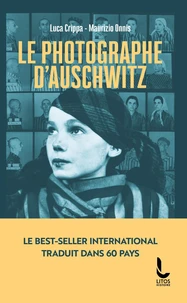Based on the powerful true story of Auschwitz prisoner number 3444 Wilhelm Brasse, whose photographs helped to expose the atrocities of the Holocaust.'Horror in sharp focus... important, because the world must know.' John Lewis-Stempel, Daily Express__________When Germany invaded Wilhelm Brasse's native Poland in 1939, he was asked to swear allegiance to Hitler and join the Wehrmacht. He refused. He was deported to Auschwitz concentration camp as political prisoner number 3444.
A trained portrait photographer, he was ordered by the SS to record the inner workings of the camp. He began by taking identification photographs of prisoners as they entered the camp, went on to capture the criminal medical experiments of Josef Mengele, and also recorded executions. Between 1940 and 1945, Brasse took around 50, 000 photographs of the horror around him. He took them because he had no choice.
Eventually, Brasse's conscience wouldn't allow him to hide behind his camera. First he risked his life by joining the camp's Resistance movement, faking documents for prisoners, trying to smuggle images to the outside world to reveal what was happening. Then, when Soviet troops finally advanced on the camp to liberate it, Brasse refused SS orders to destroy his photographs. 'Because the world must know, ' he said.
For readers of The Librarian of Auschwitz and The Boy Who Followed His Father into Auschwitz, this powerful true story of hope and courage lies at the very centre of Holocaust history.__________'A remarkable tale of survival against the odds... an enthralling book.' The Sydney Morning Herald'Brasse has left us with a powerful legacy in images. Because of them we can see the victims of the Holocaust as human and not statistics.' Fergal Keane
Based on the powerful true story of Auschwitz prisoner number 3444 Wilhelm Brasse, whose photographs helped to expose the atrocities of the Holocaust.'Horror in sharp focus... important, because the world must know.' John Lewis-Stempel, Daily Express__________When Germany invaded Wilhelm Brasse's native Poland in 1939, he was asked to swear allegiance to Hitler and join the Wehrmacht. He refused. He was deported to Auschwitz concentration camp as political prisoner number 3444.
A trained portrait photographer, he was ordered by the SS to record the inner workings of the camp. He began by taking identification photographs of prisoners as they entered the camp, went on to capture the criminal medical experiments of Josef Mengele, and also recorded executions. Between 1940 and 1945, Brasse took around 50, 000 photographs of the horror around him. He took them because he had no choice.
Eventually, Brasse's conscience wouldn't allow him to hide behind his camera. First he risked his life by joining the camp's Resistance movement, faking documents for prisoners, trying to smuggle images to the outside world to reveal what was happening. Then, when Soviet troops finally advanced on the camp to liberate it, Brasse refused SS orders to destroy his photographs. 'Because the world must know, ' he said.
For readers of The Librarian of Auschwitz and The Boy Who Followed His Father into Auschwitz, this powerful true story of hope and courage lies at the very centre of Holocaust history.__________'A remarkable tale of survival against the odds... an enthralling book.' The Sydney Morning Herald'Brasse has left us with a powerful legacy in images. Because of them we can see the victims of the Holocaust as human and not statistics.' Fergal Keane

 , qui est-ce ?
, qui est-ce ?